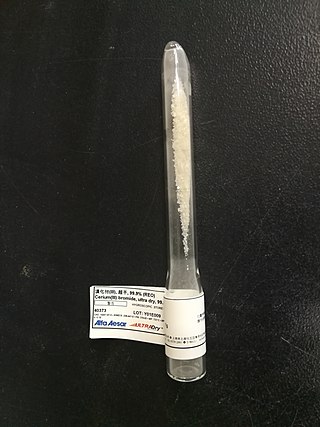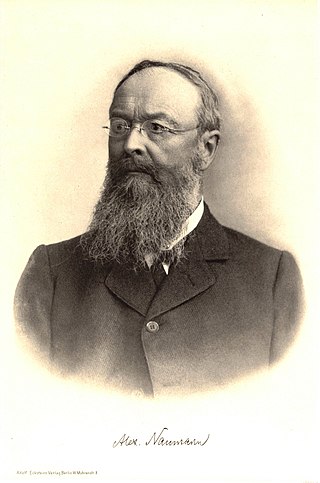In organic chemistry, a carbene is a molecule containing a neutral carbon atom with a valence of two and two unshared valence electrons. The general formula is R−:C−R' or R=C: where the R represents substituents or hydrogen atoms.
Clemmensen reduction is a chemical reaction described as a reduction of ketones or aldehydes to alkanes using zinc amalgam and concentrated hydrochloric acid (HCl). This reaction is named after Erik Christian Clemmensen, a Danish-American chemist.
The Bischler–Möhlau indole synthesis, also often referred to as the Bischler indole synthesis, is a chemical reaction that forms a 2-aryl-indole from an α-bromo-acetophenone and excess aniline; it is named after August Bischler and Richard Möhlau .
The Ullmann reaction or Ullmann coupling, named after Fritz Ullmann, couples two aryl or alkyl groups with the help of copper. The reaction was first reported by Ullmann and his student Bielecki in 1901. It has been later shown that palladium and nickel can also be effectively used.

Indene is an aromatic, polycyclic hydrocarbon with chemical formula C9H8. It is composed of a benzene ring fused with a cyclopentene ring. This flammable liquid is colorless although samples often are pale yellow. The principal industrial use of indene is in the production of indene/coumarone thermoplastic resins. Substituted indenes and their closely related indane derivatives are important structural motifs found in many natural products and biologically active molecules, such as sulindac.
Diisopropylamine is a secondary amine with the chemical formula (Me2CH)2NH (Me = methyl). Diisopropylamine is a colorless liquid with an ammonia-like odor. Its lithium derivative, lithium diisopropylamide, known as LDA is a widely used reagent.
The Wurtz–Fittig reaction is the chemical reaction of an aryl halide, alkyl halides, and sodium metal to give substituted aromatic compounds. Following the work of Charles Adolphe Wurtz on the sodium-induced coupling of alkyl halides, Wilhelm Rudolph Fittig extended the approach to the coupling of an alkyl halide with an aryl halide. This modification of the Wurtz reaction is considered a separate process and is named for both scientists.

Arthur Rudolf Hantzsch was a German chemist.

Giacomo Luigi Ciamician was an Italian chemist and senator. He was a pioneer in photochemistry and green chemistry.
Palladium black is a coarse, sponge-like form of elemental palladium which offers a large surface area for catalytic activity. It is used in organic synthesis as a catalyst for hydrogenation reactions.

Cerium(III) bromide is an inorganic compound with the formula CeBr3. This white hygroscopic solid is of interest as a component of scintillation counters.

Pregnanediol, or 5β-pregnane-3α,20α-diol, is an inactive metabolic product of progesterone. A test can be done to measure the amount of pregnanediol in urine, which offers an indirect way to measure progesterone levels in the body.

Apigeninidin is a chemical compound belonging to the 3-deoxyanthocyanidins and that can be found in the Patagonian plant Ephedra frustillata and in the soybean. Apigeninidin is one of the principal pigments found in sorghum. Extremely high level of apigeninidin (49 mg/g) has been documented in sorghum leaf sheath. Like all anthocyanidins it exists in a variety of tautomers depending on pH and hydration, several of these bare the distinctive pyrylium core.

Cobalt tetracarbonyl hydride is an organometallic compound with the formula HCo(CO)4. It is a volatile, yellow liquid that forms a colorless vapor and has an intolerable odor. The compound readily decomposes upon melt and in absentia of high CO partial pressures forms Co2(CO)8. Despite operational challenges associated with its handling, the compound has received considerable attention for its ability to function as a catalyst in hydroformylation. In this respect, HCo(CO)4 and related derivatives have received significant academic interest for their ability to mediate a variety of carbonylation (introduction of CO into inorganic compounds) reactions.

Roland Heinrich Scholl was a Swiss chemist who taught at various European universities. Among his most notable achievements are the synthesis of coronene, the co-development of the Bally-Scholl synthesis, and various discoveries about polycyclic aromatic hydrocarbons.
Alexander Ellinger was a German chemist and pharmacologist.

Diaminomaleonitrile (DAMN) is an organic compound composed of two amino groups and two nitrile groups bonded to a central alkene unit. The systematic name reflects its relationship to maleic acid.

Alexander Nikolaus Franz Naumann was a Prussian and German physical chemist and a professor at the University of Giessen. He was a pioneer of chemical thermodynamics and proposed that molecules reacted when their energy levels exceeded a certain critical level which could be achieved through the provision of heat.
Millicent Taylor FRSC MSc DSc was a chemist who, in 1904, was one of the nineteen women who petitioned to join the Chemical Society

Karl Ludwig Reimer was a German chemist and industrialist. He's responsible for the cheap synthesis of the chemical compound Vanillin, having discovered the Reimer-Tiemann Reaction.















